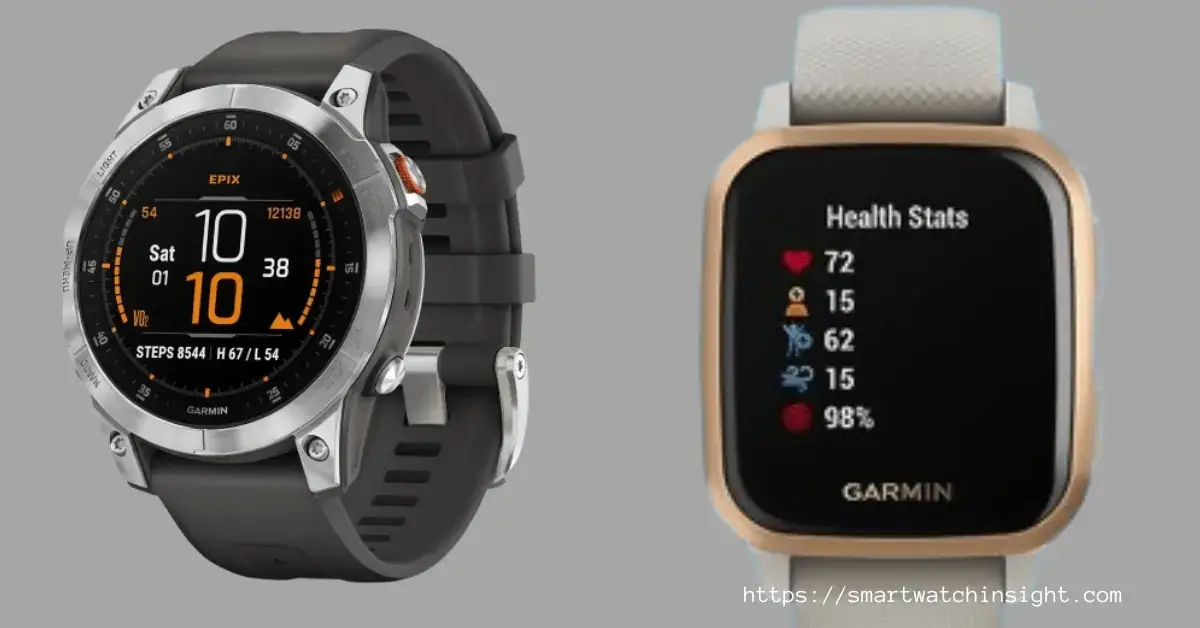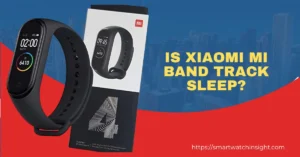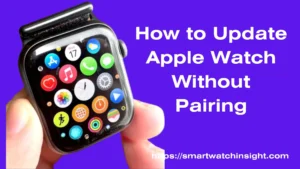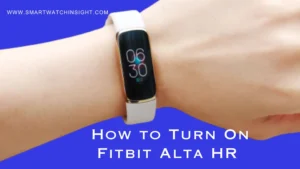Choosing the best running smartwatch can be a pivotal decision in enhancing your fitness journey. With a plethora of options available in the market, it’s essential to consider several factors to ensure you find the perfect companion for your runs.
Here’s a comprehensive guide on How to Choose the Best Smartwatch for Running:
How to Choose the Best Smartwatch for Running
There are a lot of factors to consider when choosing the best smartwatch for running, but some of the most important include:
1. Define Your Needs and Goals
Defining your needs and goals is the foundational step in selecting the best running watch for your fitness journey. Your running goals will shape the features and functionalities you require in a watch, ensuring it aligns perfectly with your aspirations and preferences.
Consider the following aspects when defining your needs and goals:
Running Goals: Are you a beginner runner aiming to improve your overall fitness, or are you an experienced athlete training for a specific race or event? Understanding your running goals will help you prioritize features that cater to your training objectives.
Running Environment: Assess where you primarily run — whether it’s on roads, trails, tracks, or a combination of terrains. Different running environments may require specific features, such as trail-specific metrics or advanced navigation capabilities, to enhance your running experience.
Key Features: Identify the key features that are essential for achieving your goals. These may include GPS tracking for accurate distance measurement, heart rate monitoring for assessing workout intensity, training metrics for performance analysis, and compatibility with third-party apps or sensors for enhanced functionality.
By clearly defining your needs and goals, you can narrow down your options and focus on selecting a running watch that perfectly suits your requirements, setting the stage for a successful and fulfilling fitness journey.
2. GPS Accuracy
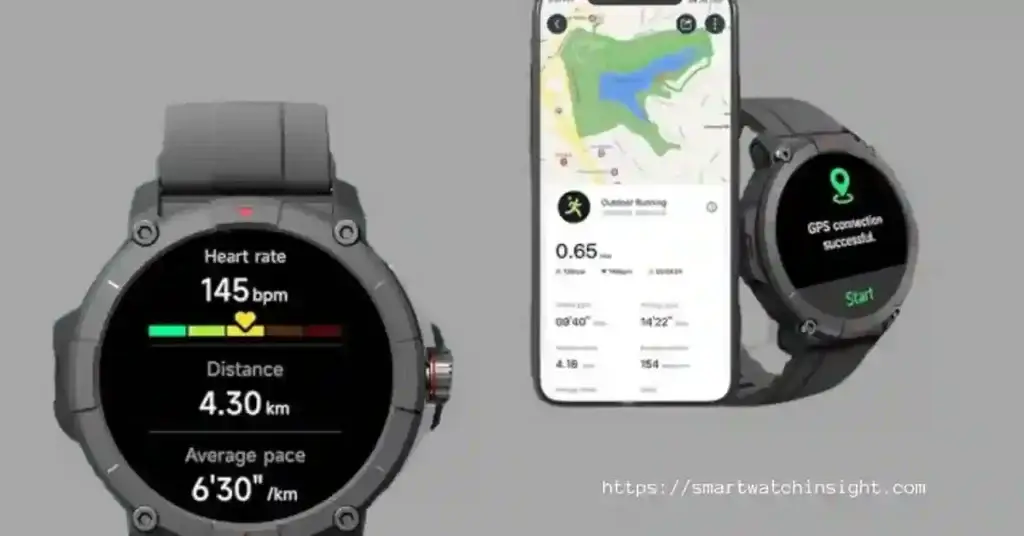
GPS accuracy is paramount when selecting a running watch, as it ensures precise tracking of your routes and accurate measurement of distance and pace.
Reliable GPS performance is particularly crucial for outdoor runners who rely on accurate location data to monitor their progress and plan their routes effectively.
When evaluating GPS accuracy in a running watch, consider the following factors:
Satellite Connectivity: Look for watches that support multiple satellite systems, such as GPS, GLONASS, or Galileo. Enhanced satellite connectivity improves signal acquisition and tracking accuracy, especially in challenging environments with obstructed or limited sky visibility.
Signal Acquisition Time: Assess the watch’s signal acquisition time, which refers to how quickly it locks onto satellite signals and establishes a connection. Watches with faster signal acquisition times provide quicker and more reliable GPS tracking, ensuring minimal wait times before starting your run.
Signal Stability: Evaluate the watch’s signal stability during your runs, particularly in areas with tall buildings, dense foliage, or rugged terrain. A stable GPS signal prevents signal dropouts and ensures consistent tracking accuracy, even in challenging environments.
By prioritizing GPS accuracy and considering factors such as satellite connectivity, signal acquisition time, and signal stability, you can select a running watch that delivers reliable performance and precise tracking for your outdoor runs.
3. Heart Rate Monitoring

Heart rate monitoring is a valuable feature in a running watch, providing insights into your workout intensity, cardiovascular health, and overall fitness level.
By tracking your heart rate during runs, you can optimize your training efforts, monitor your progress, and make informed decisions to improve your performance and well-being.
When evaluating heart rate monitoring capabilities in a running watch, consider the following factors:
Wrist-Based vs. Chest Strap: Determine whether you prefer wrist-based heart rate monitoring or compatibility with external chest strap heart rate monitors.
While wrist-based monitors offer convenience and ease of use, chest strap monitors may provide more accurate and reliable heart rate readings, especially during high-intensity workouts.
Accuracy and Precision: Assess the accuracy and precision of the watch’s heart rate monitoring technology through user reviews, expert evaluations, and real-world testing. Look for watches that deliver consistent and reliable heart rate measurements across various running conditions and intensities.
Heart Rate Zones: Consider whether the watch provides customizable heart rate zones and real-time heart rate feedback during your runs.
Heart rate zones help you optimize your training by targeting specific intensity levels based on your fitness goals, such as fat-burning, aerobic conditioning, or anaerobic threshold training.
Additional Features: Explore additional features related to heart rate monitoring, such as heart rate variability (HRV) analysis, resting heart rate tracking, and recovery metrics.
These features offer valuable insights into your overall cardiovascular health, stress levels, and recovery status, empowering you to make informed decisions to optimize your training and well-being.
By prioritizing heart rate monitoring and considering factors such as monitoring technology, accuracy, precision, and additional features, you can select a running watch that effectively tracks your heart rate and enhances your training experience, leading to improved performance and health outcomes.
4. Battery Life
Battery life is a critical consideration when choosing a running watch, as it determines the device’s longevity and reliability during your runs and workouts.
Whether you’re embarking on a short training run or an ultramarathon, a long-lasting battery ensures your watch remains powered throughout your activity, providing uninterrupted tracking and essential features when you need them most.
When evaluating battery life in a running watch, consider the following factors:
Smartwatch Mode vs. GPS Mode: Assess the battery life in both smartwatch mode (i.e., standard use without GPS) and GPS mode (i.e., active use with GPS tracking enabled).
Watches with extended battery life in both modes offer versatility and reliability for everyday wear and active use during workouts and outdoor adventures.
Battery Saving Modes: Explore battery-saving features and modes available in the watch, such as power-saving modes, ultra-trac mode, or customizable settings to optimize battery usage based on your preferences and activity duration.
These features help prolong battery life during longer runs or when extended GPS tracking is required.
Charging Time and Convenience: Evaluate the watch’s charging time and convenience of charging methods, such as wireless charging, magnetic charging connectors, or USB charging cables.
Watches with fast-charging capabilities and convenient charging options ensure quick and hassle-free charging between workouts, minimizing downtime and ensuring your watch is always ready for action.
Activity-Specific Battery Life: Consider the watch’s battery life for specific activities or use cases, such as running, cycling, swimming, or outdoor navigation. Watches optimized for endurance sports or outdoor adventures may offer extended battery life and specialized features tailored to the demands of these activities.
By prioritizing battery life and considering factors such as smartwatch mode vs. GPS mode, battery-saving features, charging time, and activity-specific battery life, you can select a running watch that meets your endurance needs, provides reliable performance during your workouts, and enhances your overall training experience.
5. Advanced Features
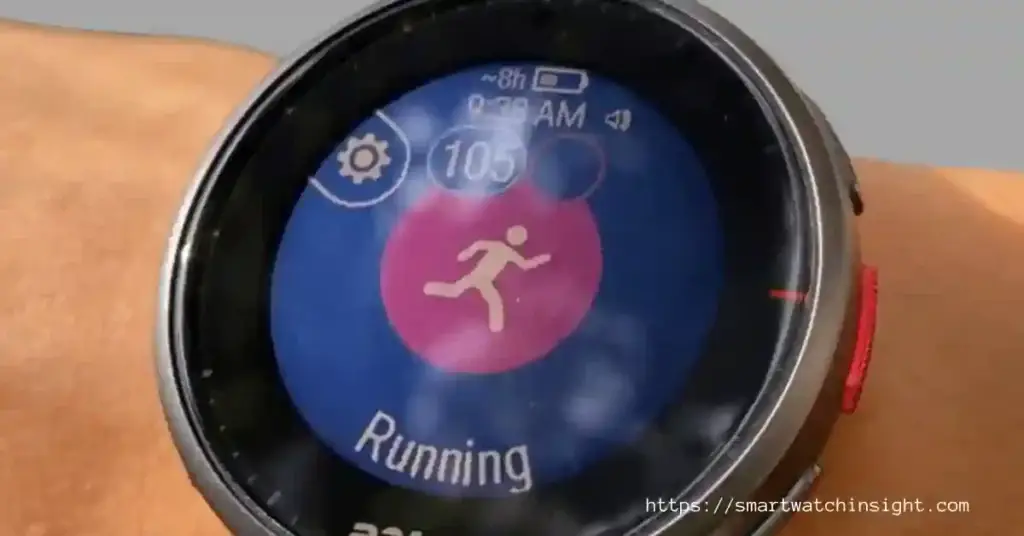
Advanced features play a significant role in enhancing the functionality and performance of a running watch, providing valuable insights, guidance, and customization options to optimize your training and improve your overall fitness level.
By exploring advanced features tailored to your specific needs and preferences, you can select a running watch that offers comprehensive support and empowers you to reach your fitness goals effectively.
Consider the following advanced features when choosing a running watch:
Training Metrics: Look for watches that provide detailed training metrics, including pace, distance, cadence, stride length, vertical oscillation, ground contact time, and other relevant running dynamics.
These metrics offer insights into your running technique, efficiency, and performance, helping you identify areas for improvement and track your progress over time.
Training Plans and Coaching: Choose watches with built-in training plans, coaching programs, or adaptive training features designed to guide and motivate you through structured workouts, interval sessions, and goal-specific training programs.
These features offer personalized guidance, feedback, and encouragement to help you stay on track, reach your targets, and achieve optimal results.
Recovery Tools: Explore recovery-oriented features and metrics, such as recovery advisor, sleep tracking, stress monitoring, and HRV analysis, to optimize your recovery, manage fatigue, and prevent overtraining. These tools provide insights into your body’s readiness for training,
recovery status, and overall well-being, enabling you to balance your training load effectively and minimize the risk of injury or burnout.
Navigation and Mapping: Assess navigation and mapping capabilities in watches designed for outdoor running, trail running, or adventure sports.
Look for features such as breadcrumb navigation, route planning, offline maps, and point-of-interest (POI) databases to navigate unfamiliar terrain, explore new routes, and stay on course during your outdoor adventures.
Music and Entertainment: Consider watches with built-in music storage, streaming capabilities, or compatibility with music apps and services to enjoy your favorite tunes, podcasts, or audiobooks during your runs.
Music can enhance your motivation, focus, and enjoyment during workouts, helping you maintain momentum and push through challenging training sessions.
Smartwatch Integration: Evaluate integration with smartwatch features and functionalities, such as smartphone notifications, app alerts, voice assistants, contactless payments, and customizable watch faces.
Seamless integration with your smartphone and other devices enhances convenience, connectivity, and versatility, allowing you to stay connected and productive while on the go.
By prioritizing advanced features and considering factors such as training metrics, coaching programs, recovery tools, navigation capabilities, music integration, and smartwatch integration, you can select a running watch that offers comprehensive support, customization, and functionality tailored to your unique needs and preferences.
Whether you’re a beginner runner striving to improve your fitness or an experienced athlete aiming for peak performance, advanced features can elevate your training experience and help you achieve your fitness goals effectively.
6. Design and Comfort
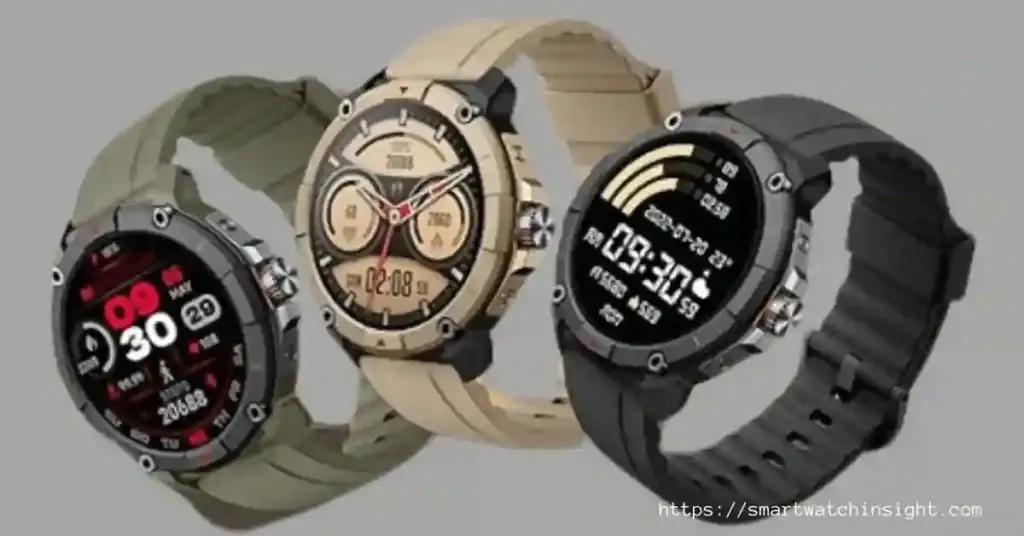
The design and comfort of a running watch significantly impact your overall experience during workouts and everyday wear, influencing factors such as comfort, fit, durability, and style.
By prioritizing design and comfort features that align with your preferences and preferences, you can select a running watch that feels comfortable, looks stylish, and withstands the rigors of your active lifestyle.
Consider the following design and comfort aspects when choosing a running watch:
Size and Weight: Assess the watch’s size and weight to ensure it feels comfortable and lightweight on your wrist, even during long runs or intense workouts. Watches with compact, streamlined designs and ergonomic shapes minimize bulk and reduce the risk of discomfort or chafing, allowing you to focus on your performance without distraction.
Strap Material and Adjustability: Evaluate the strap material, construction, and adjustability to ensure a secure, snug fit that remains comfortable during movement and perspiration.
Look for watches with breathable, moisture-wicking straps made from flexible, durable materials such as silicone, nylon, or elastomer, providing comfort and stability in various weather conditions and activities.
Water Resistance and Durability: Check the watch’s water resistance rating and durability features to ensure it can withstand exposure to sweat, rain, splashes, or immersion in water during aquatic activities such as swimming or triathlon training.
Watches with high water resistance ratings (e.g., ATM or meters) and robust construction materials (e.g., stainless steel, reinforced polymer) offer peace of mind and longevity, even in challenging environments.
Display Visibility and Legibility: Assess the display visibility and legibility in different lighting conditions, including bright sunlight, low light, or nighttime running.
Look for watches with high-resolution, sunlight-readable displays, adjustable brightness settings, and anti-glare coatings to ensure clear, sharp visibility and readability, minimizing eyestrain and enhancing user experience during outdoor activities.
Button Layout and Navigation: Evaluate the button layout, interface, and navigation controls to ensure intuitive operation and easy access to essential functions during workouts.
Look for watches with tactile, responsive buttons, intuitive menu systems, and customizable shortcuts for quick access to frequently used features, allowing you to navigate menus, start/stop workouts, and view data effortlessly while on the move.
Aesthetic Appeal and Style: Consider the watch’s aesthetic appeal, style, and customization options to reflect your taste, preferences, and lifestyle.
Look for watches with interchangeable straps, customizable watch faces, and sleek, modern designs that complement your wardrobe and reflect your individuality, allowing you to express yourself while staying active and fashionable.
By prioritizing design and comfort features such as size, weight, strap material, water resistance, display visibility, button layout, and aesthetic appeal, you can select a running watch that feels comfortable, looks stylish, and enhances your overall experience during workouts and everyday wear.
Whether you’re hitting the trails, pounding the pavement, or tracking your progress at the gym, a well-designed, comfortable watch ensures you stay motivated, focused, and confident as you pursue your fitness goals.
7. Compatibility and Connectivity
Compatibility and connectivity are essential considerations when choosing a running watch, as they determine the device’s interoperability with other devices, platforms, and services, ensuring seamless data syncing, integration, and functionality.
By prioritizing compatibility and connectivity features that align with your existing devices, software, and preferences, you can select a running watch that integrates effortlessly with your ecosystem, enhances your user experience, and maximizes the value of your investment.
Consider the following compatibility and connectivity aspects when choosing a running watch:
Smartphone Compatibility: Ensure the watch is compatible with your smartphone’s operating system (e.g., iOS or Android) and software version to enable seamless pairing, data syncing, and app integration.
Look for watches with dedicated companion apps available on the respective app stores, providing access to additional features, settings, and customization options tailored to your device platform.
App Integration: Assess the watch’s compatibility with popular fitness apps, platforms, and services to ensure it syncs data accurately and seamlessly with your preferred apps for activity tracking, workout analysis, and goal tracking.
Look for watches that support integration with leading fitness apps, such as Strava, Nike Run Club, Garmin Connect, or Apple Health, allowing you to consolidate and analyze your fitness data across multiple platforms and services.
Sensor Compatibility: Explore the watch’s compatibility with external sensors and accessories, such as heart rate monitors, foot pods, cycling sensors, or power meters, to expand its functionality and enhance your training experience.
Look for watches with ANT+ or Bluetooth connectivity protocols, supporting interoperability with a wide range of sensors and devices from different manufacturers, ensuring flexibility and versatility in your fitness setup.
Wireless Connectivity: Check the watch’s wireless connectivity options, such as Bluetooth, Wi-Fi, or NFC, for convenient data transfer, firmware updates, and smartwatch features.
Look for watches with Bluetooth Low Energy (BLE) technology for energy-efficient wireless communication, enabling seamless connectivity with your smartphone, wireless headphones, or other Bluetooth-enabled devices without draining the watch’s battery excessively.
Cloud Syncing and Backup: Evaluate the watch’s cloud syncing and backup capabilities, allowing you to store, access, and restore your fitness data securely across multiple devices and platforms.
Look for watches that support cloud-based syncing services, such as Garmin Connect, Strava, or Apple iCloud, providing automatic data backups, multi-device synchronization, and cross-platform accessibility for enhanced data management and peace of mind.
Smartwatch Features: Explore smartwatch features and functionalities, such as smartphone notifications, app alerts, voice assistants, contactless payments, and customizable watch faces, to enhance your connectivity, productivity, and convenience while on the go.
Look for watches with seamless integration with your smartphone’s ecosystem, allowing you to receive notifications, messages, calls, and calendar reminders directly on your wrist, without needing to check your phone constantly.
By prioritizing compatibility and connectivity features such as smartphone compatibility, app integration, sensor compatibility, wireless connectivity, cloud syncing, and smartwatch features, you can select a running watch that seamlessly integrates with your existing devices, software, and lifestyle, ensuring a cohesive and streamlined user experience.
Whether you’re syncing your workouts with your favorite fitness app, tracking your progress across multiple devices, or staying connected and productive on the go, compatibility and connectivity features enhance the functionality and versatility of your running watch, empowering you to achieve your fitness goals effectively and efficiently.
8. Budget
Setting a budget is a crucial step when choosing a running watch, as it helps you narrow down your options and prioritize features based on your financial constraints and preferences.
By establishing a budget range that aligns with your needs and expectations, you can select a running watch that offers the best value for your money, balancing performance, features, and affordability effectively.
Consider the following factors when setting a budget for your running watch:
Feature Prioritization: Determine which features are essential for your running needs and goals, and prioritize them accordingly within your budget range.
Identify must-have features that directly contribute to your training effectiveness, performance improvement, and overall user experience, ensuring you invest in a watch that meets your functional requirements and delivers tangible benefits.
Performance vs. Price: Evaluate the trade-offs between performance and price when comparing different running watches within your budget range.
Consider factors such as GPS accuracy, heart rate monitoring, battery life, durability, and advanced features relative to their cost, ensuring you select a watch that offers the best combination of performance and value within your financial constraints.
Long-Term Investment: Assess the long-term value and return on investment (ROI) of the running watch beyond its initial purchase price.
Consider factors such as software updates, firmware support, warranty coverage, and upgradeability, ensuring your watch remains relevant, functional, and supported over time, even as technology evolves and new features are introduced.
Research and Comparison: Research and compare running watches across different brands, models, and price points to identify the best options that fit your budget and requirements.
Explore online reviews, user feedback, expert recommendations, and comparison tools to gain insights into each watch’s performance, reliability, features, and value proposition, enabling you to make an informed decision and maximize the value of your investment.
Value Proposition: Evaluate the overall value proposition of each running watch, considering its features, performance, durability, brand reputation, customer support, and aftermarket accessories.
Look for watches that offer a compelling combination of quality, functionality, and affordability, providing excellent value for your money and satisfaction over time.
By setting a budget, prioritizing features, comparing options, and assessing value proposition, you can select a running watch that offers the best balance of performance, features, and affordability within your financial constraints.
Whether you’re a budget-conscious beginner or a seasoned athlete seeking advanced features, establishing a clear budget ensures you make a smart and cost-effective investment in a running watch that meets your needs, enhances your training experience, and helps you achieve your fitness goals effectively, and efficiently.
9. Reviews and Recommendations
Reviews and recommendations are invaluable resources when choosing a running watch, providing insights, perspectives, and firsthand experiences from users, experts, and industry professionals.
By researching and considering reviews and recommendations from credible sources, you can gain valuable insights into each watch’s performance, features, reliability, and user experience, empowering you to make an informed decision and select the best running watch for your needs and preferences.
Consider the following sources when seeking reviews and recommendations for running watches:
Expert Reviews: Explore reviews and evaluations from reputable publications, websites, and industry experts specializing in fitness technology, wearables, and sports performance.
Look for in-depth reviews, hands-on testing, and expert opinions that assess each watch’s design, performance, features, accuracy, and suitability for different running needs and scenarios, providing valuable insights and recommendations based on objective analysis and expertise.
User Feedback: Seek feedback and testimonials from fellow runners, athletes, and fitness enthusiasts who have firsthand experience using the running watches you’re considering.
Look for user reviews, ratings, forums, social media discussions, and online communities where users share their experiences, impressions, and opinions about each watch’s performance, durability, comfort, and functionality, offering valuable insights and real-world perspectives that can inform your decision-making process.
Comparison Tools: Use comparison tools and resources that allow you to compare running watches side by side, highlighting their features, specifications, pros, cons, and price points.
Explore interactive comparison charts, tables, and matrices available on websites, forums, and shopping platforms, enabling you to evaluate and contrast multiple watches simultaneously, identify key differences, and determine which watch best meets your needs and preferences based on your priorities and criteria.
Retailer Recommendations: Consult retailer recommendations, buyer’s guides, and curated lists featuring top-rated running watches recommended by retailers, online stores, and specialty shops.
Look for curated collections, editor’s picks, bestseller rankings, and customer favorites that showcase popular and highly-rated running watches based on sales performance, customer satisfaction, and expert endorsements, providing convenient options and starting points for your research and selection process.
Community Feedback: Engage with the running and fitness community through social media platforms, online forums, running clubs, and local meetups to solicit recommendations, advice, and personal anecdotes from fellow enthusiasts.
Participate in discussions, ask questions, and share your requirements and preferences to receive personalized recommendations, insights, and recommendations tailored to your specific needs and circumstances, fostering collaboration, camaraderie, and support within the community.
By leveraging reviews and recommendations from experts, users, retailers, and community members, you can gain valuable insights, perspectives, and recommendations that inform your decision-making process and help you select the best running watch for your needs, preferences, and budget.
Whether you’re seeking objective evaluations, real-world experiences, or personalized advice, reviews, and recommendations offer valuable guidance and support to help you make an informed decision and choose a running watch that enhances your training experience, motivates you to achieve your fitness goals, and inspires you to pursue your passion for running.
Conclusion
Choosing the best running watch requires careful consideration of various factors, including your needs, goals, preferences, and budget. By evaluating key criteria such as GPS accuracy, heart rate monitoring, battery life, advanced features, design, compatibility, and reviews, you can select a running watch that meets your requirements, enhances your training experience, and helps you achieve your fitness goals effectively and efficiently.
Whether you’re a beginner runner embarking on your fitness journey or an experienced athlete striving for peak performance, the right running watch serves as a valuable companion, providing guidance, motivation, and feedback to support your progress and success.
By prioritizing features, comparing options, and seeking insights from reviews and recommendations, you can confidently choose a running watch that empowers you to run smarter, train harder, and unlock your full potential as a runner, ensuring you enjoy a fulfilling and rewarding fitness experience for years to come.
You may also like :- Which Garmin Running Smartwatch Is Best For You?
Q. What features should a runner look for in a smartwatch?
When selecting a smartwatch to optimize your running experience, prioritize features that enhance core performance metrics. Essential functions include GPS tracking for precise distance and pace monitoring, as well as heart rate monitoring to gauge exertion and optimize training zones. Extended battery life ensures the watch lasts throughout your run, even for longer distances. Durability is crucial to withstand sweat, rain, and potential bumps. For additional functionality, consider options with built-in music storage, contactless payments for on-the-go convenience, or even coaching features to elevate your training regimen.

